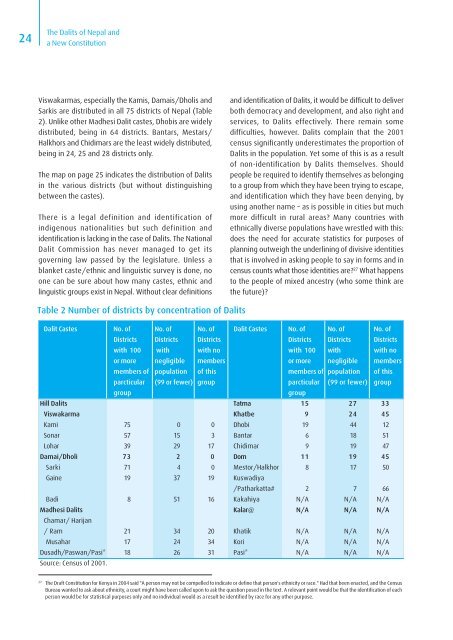The Dalits of Nepal and a New Constitution - ConstitutionNet
The Dalits of Nepal and a New Constitution - ConstitutionNet
The Dalits of Nepal and a New Constitution - ConstitutionNet
Create successful ePaper yourself
Turn your PDF publications into a flip-book with our unique Google optimized e-Paper software.
24<br />
<strong>The</strong> <strong>Dalits</strong> <strong>of</strong> <strong>Nepal</strong> <strong>and</strong><br />
a <strong>New</strong> <strong>Constitution</strong><br />
Viswakarmas, especially the Kamis, Damais/Dholis <strong>and</strong><br />
Sarkis are distributed in all 75 districts <strong>of</strong> <strong>Nepal</strong> (Table<br />
2). Unlike other Madhesi Dalit castes, Dhobis are widely<br />
distributed, being in 64 districts. Bantars, Mestars/<br />
Halkhors <strong>and</strong> Chidimars are the least widely distributed,<br />
being in 24, 25 <strong>and</strong> 28 districts only.<br />
<strong>The</strong> map on page 25 indicates the distribution <strong>of</strong> <strong>Dalits</strong><br />
in the various districts (but without distinguishing<br />
between the castes).<br />
<strong>The</strong>re is a legal definition <strong>and</strong> identification <strong>of</strong><br />
indigenous nationalities but such definition <strong>and</strong><br />
identification is lacking in the case <strong>of</strong> <strong>Dalits</strong>. <strong>The</strong> National<br />
Dalit Commission has never managed to get its<br />
governing law passed by the legislature. Unless a<br />
blanket caste/ethnic <strong>and</strong> linguistic survey is done, no<br />
one can be sure about how many castes, ethnic <strong>and</strong><br />
linguistic groups exist in <strong>Nepal</strong>. Without clear definitions<br />
<strong>and</strong> identification <strong>of</strong> <strong>Dalits</strong>, it would be difficult to deliver<br />
both democracy <strong>and</strong> development, <strong>and</strong> also right <strong>and</strong><br />
services, to <strong>Dalits</strong> effectively. <strong>The</strong>re remain some<br />
difficulties, however. <strong>Dalits</strong> complain that the 2001<br />
census significantly underestimates the proportion <strong>of</strong><br />
<strong>Dalits</strong> in the population. Yet some <strong>of</strong> this is as a result<br />
<strong>of</strong> non-identification by <strong>Dalits</strong> themselves. Should<br />
people be required to identify themselves as belonging<br />
to a group from which they have been trying to escape,<br />
<strong>and</strong> identification which they have been denying, by<br />
using another name – as is possible in cities but much<br />
more difficult in rural areas? Many countries with<br />
ethnically diverse populations have wrestled with this:<br />
does the need for accurate statistics for purposes <strong>of</strong><br />
planning outweigh the underlining <strong>of</strong> divisive identities<br />
that is involved in asking people to say in forms <strong>and</strong> in<br />
census counts what those identities are? 27 What happens<br />
to the people <strong>of</strong> mixed ancestry (who some think are<br />
the future)?<br />
Table 2 Number <strong>of</strong> districts by concentration <strong>of</strong> <strong>Dalits</strong><br />
Dalit Castes No. <strong>of</strong> No. <strong>of</strong> No. <strong>of</strong> Dalit Castes No. <strong>of</strong> No. <strong>of</strong> No. <strong>of</strong><br />
Districts Districts Districts Districts Districts Districts<br />
with 100 with with no with 100 with with no<br />
or more negligible members Dalit Castes or more negligible members<br />
members <strong>of</strong> population <strong>of</strong> this members <strong>of</strong> population <strong>of</strong> this<br />
parcticular (99 or fewer) group parcticular (99 or fewer) group<br />
group<br />
group<br />
Hill <strong>Dalits</strong> Tatma 15 27 33<br />
Viswakarma Khatbe 9 24 45<br />
Kami 75 0 0 Dhobi 19 44 12<br />
Sonar 57 15 3 Bantar 6 18 51<br />
Lohar 39 29 17 Chidimar 9 19 47<br />
Damai/Dholi 73 2 0 Dom 11 19 45<br />
Sarki 71 4 0 Mestor/Halkhor 8 17 50<br />
Gaine 19 37 19 Kuswadiya<br />
/Patharkatta# 2 7 66<br />
Badi 8 51 16 Kakahiya N/A N/A N/A<br />
Madhesi <strong>Dalits</strong> Kalar@ N/A N/A N/A<br />
Chamar/ Harijan<br />
/ Ram 21 34 20 Khatik N/A N/A N/A<br />
Musahar 17 24 34 Kori N/A N/A N/A<br />
Dusadh/Paswan/Pasi* 18 26 31 Pasi* N/A N/A N/A<br />
Source: Census <strong>of</strong> 2001.<br />
27<br />
<strong>The</strong> Draft <strong>Constitution</strong> for Kenya in 2004 said "A person may not be compelled to indicate or define that person's ethnicity or race." Had that been enacted, <strong>and</strong> the Census<br />
Bureau wanted to ask about ethnicity, a court might have been called upon to ask the question posed in the text. A relevant point would be that the identification <strong>of</strong> each<br />
person would be for statistical purposes only <strong>and</strong> no individual would as a result be identified by race for any other purpose.








![g]k fnsf blntx? / gofF ;+l jwfg](https://img.yumpu.com/49483602/1/184x260/gk-fnsf-blntx-goff-l-jwfg.jpg?quality=85)



![+ljwfg;ef, /fHosf]k'g](https://img.yumpu.com/41604075/1/184x260/-ljwfgef-fhosfkg.jpg?quality=85)




